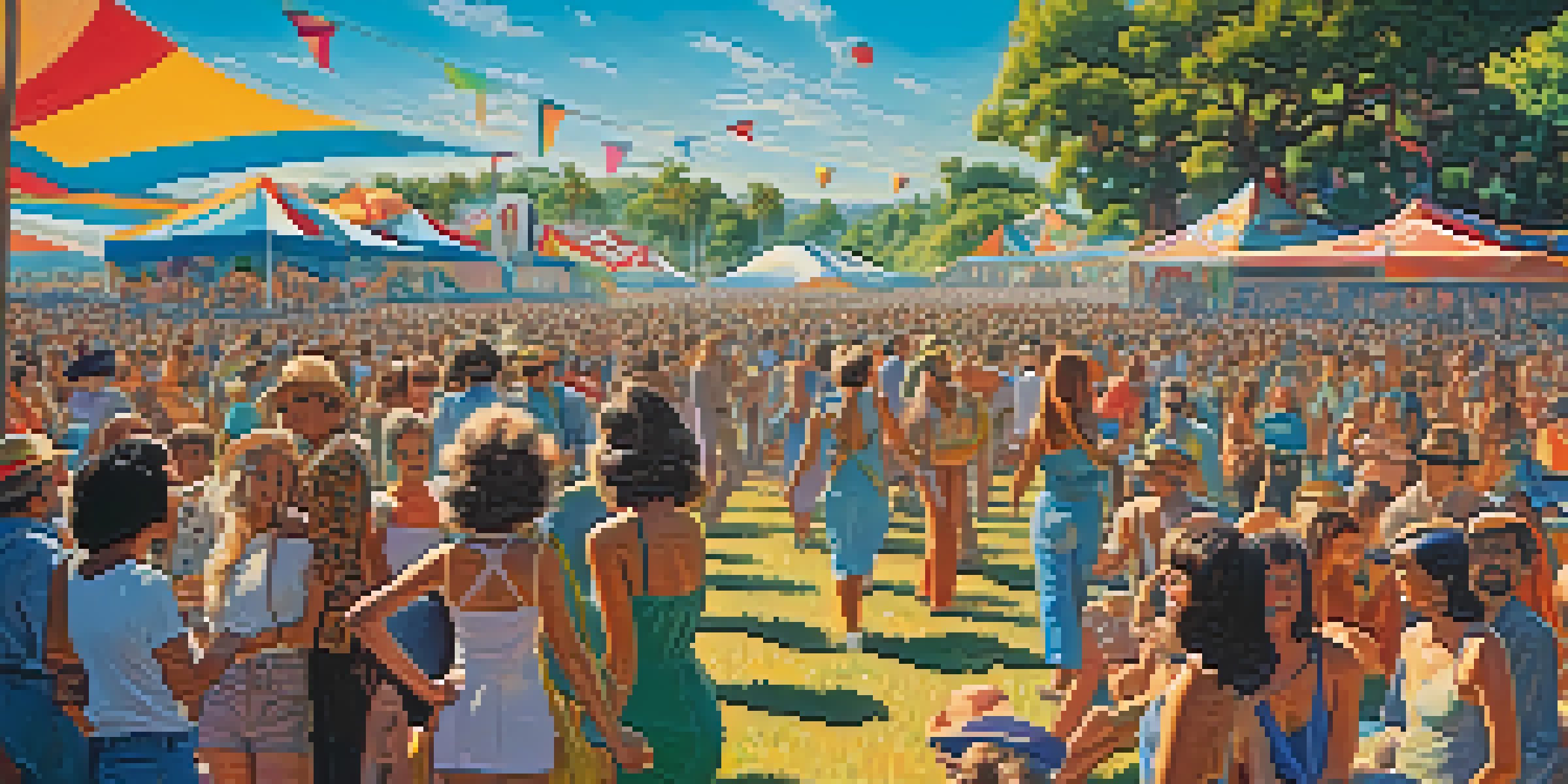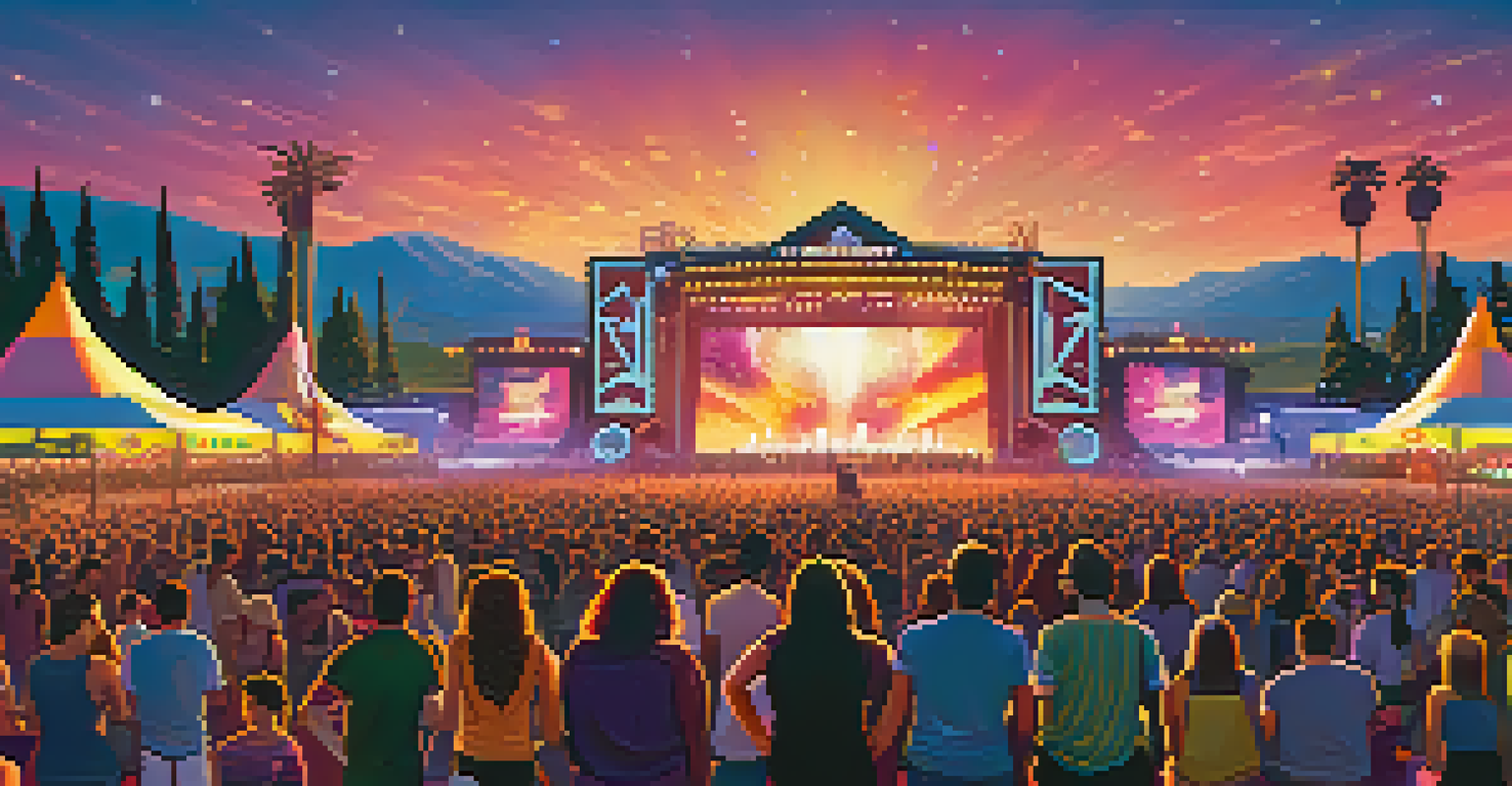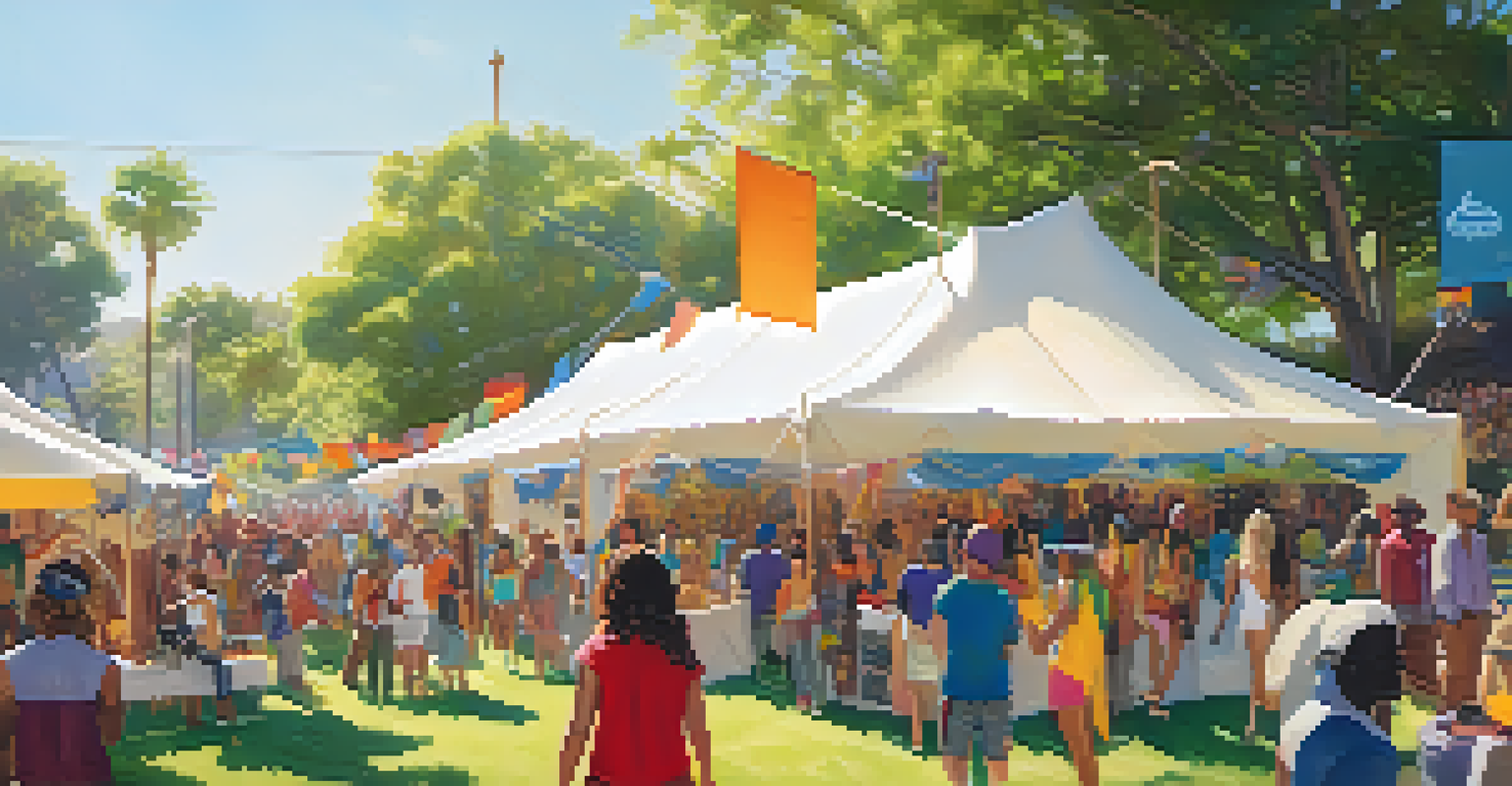The Evolution of Music Festivals in California Over the Years

The Birth of Music Festivals in California: 1960s-1970s
California's music festival scene truly began in the 1960s, marked by the iconic Monterey Pop Festival in 1967. This event not only introduced legendary artists like Janis Joplin and Jimi Hendrix but also set the stage for a new era of music celebration. It was a time when music was intertwined with social movements, and festivals became a gathering place for youth seeking expression and community.
Music can change the world because it can change people.
As the 1970s rolled in, the popularity of music festivals soared, with events like the California Jam and the Us Festival attracting massive crowds. These festivals showcased a wide variety of genres, reflecting the diverse musical landscape of the time. They also began to incorporate elaborate stage designs and light shows, enhancing the overall experience for attendees.
During this era, the festival culture began to evolve beyond just music; it became a lifestyle. People traveled far and wide to experience these events, creating a sense of camaraderie and shared passion. This laid the groundwork for the vibrant festival culture California is known for today.
The Rise of Iconic Festivals: 1980s-1990s
The 1980s saw the emergence of some of California's most iconic festivals, such as Coachella, which began in 1999. Though it started as a relatively small event, Coachella quickly grew into a cultural phenomenon, attracting major artists and fans from all over the globe. This festival not only revolutionized the music scene but also introduced the concept of boutique festivals, focusing on unique experiences.

In the same vein, Lollapalooza emerged in 1991 as a traveling festival, showcasing alternative rock and punk bands. This festival brought together diverse musical acts, creating a melting pot of genres and cultures. The success of these festivals highlighted the growing demand for live music experiences, pushing organizers to innovate and expand their offerings.
California Festivals: A Cultural Evolution
From the 1960s to today, California's music festivals have transformed into vibrant cultural events that reflect social movements and diverse musical genres.
As the 90s progressed, festivals began to incorporate more than just music. Art installations, food vendors, and workshops sprang up, transforming festivals into immersive experiences. This shift reflected a broader cultural movement where music festivals became a space for creativity and self-expression.
The Digital Age: Festivals in the 2000s
With the dawn of the 2000s, technology played a significant role in the evolution of music festivals. Online ticket sales and social media platforms like MySpace and Facebook allowed fans to connect with festivals and artists like never before. This digital shift made it easier for festivals to promote themselves and reach a wider audience, boosting attendance significantly.
Festivals are a way to celebrate life, to celebrate our connections with each other.
Additionally, the rise of streaming services changed how people consumed music, and festivals adapted accordingly. Many began to offer live streaming options, allowing fans who couldn't attend in person to experience the magic from home. This accessibility opened up a new avenue for engagement, making music festivals a global affair.
Moreover, the increasing popularity of electronic dance music (EDM) during this decade led to the emergence of festivals like Electric Daisy Carnival. These events showcased cutting-edge visuals and high-energy performances, attracting a younger demographic and expanding the music festival landscape even further.
The Impact of COVID-19 on Music Festivals: 2020
The COVID-19 pandemic brought the live music industry to a standstill in 2020, forcing many festivals to cancel or pivot to virtual formats. This unprecedented situation challenged festival organizers to think creatively about how to engage fans while ensuring safety. Online performances became a temporary solution, allowing artists to connect with audiences in a new way.
As the pandemic progressed, discussions about health protocols and safety measures became crucial for the future of festivals. Many organizers began to explore hybrid models that combined in-person and virtual experiences, ensuring flexibility and accessibility for attendees. This adaptation demonstrated the resilience of the music festival community and its commitment to connecting people through music.
Technology's Role in Festival Growth
The integration of technology has revolutionized music festivals, enhancing attendee experiences through online engagement and innovative features.
While the initial impact was devastating, the pandemic also sparked a wave of innovation. Festivals began to prioritize sustainability and inclusivity, paving the way for a more conscientious approach to event planning. As California slowly reopened, the music festival scene emerged with a renewed focus on community and shared experiences.
The Return of In-Person Festivals: 2021 and Beyond
As restrictions eased in 2021, music festivals began to make a comeback, much to the delight of fans and artists alike. Events like Coachella and Outside Lands returned with new health guidelines, including vaccination checks and enhanced sanitation measures. This resurgence marked a significant milestone in the recovery of the live music industry, rekindling the vibrant atmosphere that festivals are known for.
The return of festivals also brought a sense of healing and joy to many after a challenging period. Attendees flocked to these events, eager to reconnect with friends and experience live music once more. The emotional release and shared joy of being together in a crowd were palpable, reminding everyone of the power of music to bring people together.
Looking forward, the future of music festivals in California seems bright. Organizers are now more focused on creating diverse lineups, increasing representation, and prioritizing sustainability. This evolution reflects the changing landscape of music and the desire for festivals to be not just entertainment but a platform for social change.
The Role of Technology in Modern Festivals
Today, technology plays a pivotal role in shaping the festival experience. From ticketing apps to augmented reality experiences, festivals are leveraging innovation to enhance attendee engagement. For instance, some festivals now offer interactive maps and real-time updates through mobile apps, making it easier for fans to navigate the grounds and discover new artists.
Moreover, social media continues to be a powerful tool for festivals to connect with audiences. Live streaming performances, behind-the-scenes content, and fan engagement campaigns have become staples of the festival experience. This digital presence not only promotes the event but also fosters a sense of community among fans before, during, and after the festival.
Resilience Post-COVID-19
The pandemic sparked innovation in music festivals, leading to hybrid models and a renewed focus on sustainability and inclusivity as they returned.
As festivals evolve, they are also exploring sustainable practices, such as cashless transactions and eco-friendly initiatives. By integrating technology with sustainability, festivals are setting new standards for the industry, attracting environmentally-conscious attendees. This blend of innovation and responsibility is shaping the future of music festivals in California and beyond.
The Cultural Significance of California Music Festivals
California music festivals have become cultural touchstones, representing the diverse tapestry of the state’s music scene. From rock and pop to hip-hop and electronic, these festivals celebrate various genres and foster inclusivity. They create spaces where people from different backgrounds can come together to share their love for music, art, and community.
Moreover, festivals often serve as platforms for social and political movements. Events like the San Francisco Pride Parade and the Oakland Music Festival highlight important cultural issues, using music as a medium for advocacy and awareness. This intersection of music and activism reflects California's rich history of social change and community engagement.

As we look to the future, the cultural significance of music festivals in California will likely continue to grow. They will remain vital in shaping the music landscape and reflecting the values and passions of their attendees. The evolution of these festivals is a testament to the enduring power of music as a unifying force in society.